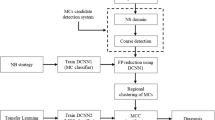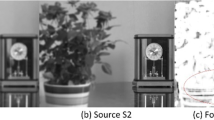Abstract
To accurately identify microcalcification clusters (MCs) in x-ray images to detect breast cancer earlier, a new MC target detection method which combines a deep fine-grained cascade-enhanced network (FCE-Net) and a multi-scale feature fusion algorithm (MFF) is proposed. First, a deep convolutional neural network model FCE-Net is established to extract characteristics of MCs. FCE-Net constructs a convolutional subnetwork within the convolutional module to enhance the multi-branch structure and thus improves the detailed feature extraction performance of MCs. Then, a multi-level, fine-grained convolutional map is generated and a multi-scale feature fusion algorithm (MFF) is constructed. In order to solve the problem of fine-grained target semantic information enhancement, MFF up-samples the basic feature map twice and then laterally connects to the previous layer. Then, through the parallel regression calculation and feature classification, the confidence and regional coordinates of MC objects are obtained. Finally, the target area is classified and bounding box adjustment is performed in the merged layer of the region of interest. We perform the proposed method on the MIAS breast cancer data set. By training and testing, the accuracy of detection is 97.16% under the N5 parameter settings. The overall model improves the detection efficiency of small targets by 5–10%.













Similar content being viewed by others
References
Feng R, Wang H, Ding Y et al (2016) To investigate the screening model of breast cancer. J Clin Radiol 35(1):36–40
Jeh SK, Kim SH, Choi JJ et al (2016) Comparison of automated breast ultrasonography to handheld ultrasonography in detecting and diagnosing breast lesions. Acta Radiol 57(2):162
Chen W, Zheng R (2015) Incidence, mortality and survival analysis of breast cancer in China. Chin J Clin Oncol 42(13):668–674
Gong H, Wang Y (2007) Detection of clustered microcalcifications in mammograms based on wavelet transformation and graphics theory. Opt Tech 33(5):769–771
Wang L, Zhu M, Deng L et al (2009) Automatic detection on clustered microcalcifications on mammograms based on 2D particles. J Comput Res Dev 46(9):1438–1445
Wang D, Li Z, Wang L et al (2012) MRI in the diagnosis of breast lesions with clustered microcalcifications showing on mammography. Radiol Pract 27(10):1089–1094
Cao P, Li B, Liu X et al (2013) Microcalcifications clusters recognition based on optimized cost-sensitive SVM combinational algorithm. J Northeast Univ (Nat Sci) 34(8):1100–1104
Gao C, Hayward RB, Müller M (2017) Move prediction using deep convolutional neural networks in Hex. IEEE Trans Games. https://doi.org/10.1109/tg.2017.2785042
Berg WA, Campassi C, Langenberg P et al (2000) Breast imaging reporting and data system. Am J Roentgenol 174(6):1769–1777
He K, Zhang X, Ren S et al (2015) Deep residual learning for image recognition. In: Proceedings of the IEEE Conference on Computer Vision and Pattern Recognition, pp 770–778
Zagoruyko S, Komodakis N (2016) Wide residual networks. arXiv:1605.07146 [cs.CV]
Wu Z, Shen C, Hengel AVD (2016) Wider or deeper: revisiting the ResNet model for visual recognition. arXiv:1611.10080 [cs.CV]
Lee Y, Kim H, Park E et al (2017) Wide-residual-inception networks for real-time object detection. In: 2017 IEEE Intelligent Vehicles Symposium (IV), pp 758–764
Szegedy C, Vanhoucke V, Ioffe S et al (2015) Rethinking the inception architecture for computer vision. In: Proceedings of the IEEE Conference on Computer Vision and Pattern Recognition, pp 2818–2826
Szegedy C, Ioffe S, Vanhoucke V et al (2016) Inception-v4, Inception-ResNet and the impact of residual connections on learning. arXiv:1602.07261 [cs.CV]
Redmon J, Divvala S, Girshick R et al (2015) You only look once: unified, real-time object detection. In: Proceedings of the IEEE Conference on Computer Vision and Pattern Recognition, pp 779–788
Ren S, He K, Girshick R et al (2015) Faster R-CNN: towards real-time object detection with region proposal networks. IEEE Trans Pattern Anal Mach Intell 39(6):1137–1149
He K, Zhang X, Ren S et al (2014) Spatial pyramid pooling in deep convolutional networks for visual recognition. IEEE Trans Pattern Anal Mach Intell 37(9):1904–1916
Lin T Y, Dollar P, Girshick R et al (2016) Feature pyramid networks for object detection. In: Proceedings of the IEEE Conference on Computer Vision and Pattern Recognition, pp 936–944
Yip M, Mackenzie A, Lewis E et al (2011) Image resampling effects in mammographic image simulation. Phys Med Biol 56(22):275–286
Li W, Dong P, Xiao B et al (2016) Object recognition based on the Region of Interest and optimal Bag of Words model. Neurocomputing 172(C):271–280
Kanamori T (2010) Deformation of log-likelihood loss function for multiclass boosting. Neural Netw 23(7):843–864
Girshick R (2015) Fast R-CNN. In: 2015 IEEE International Conference on Computer Vision (ICCV), Santiago, pp 1440–1448. https://doi.org/10.1109/iccv.2015.169
He K, Zhang X, Ren S et al (2015) Delving deep into rectifiers: surpassing human-level performance on ImageNet classification. In: Proceedings of the IEEE International Conference on Computer Vision, pp 1026–1034
Nesterov Y, Spokoiny V (2017) Random gradient-free minimization of convex functions. Found Comput Math 17(2):527–566
Botev A, Lever G, Barber D (2017) Nesterov’s accelerated gradient and momentum as approximations to regularised update descent. In: 2017 International Joint Conference on Neural Networks (IJCNN), Anchorage, AK, pp 1899–1903. https://doi.org/10.1109/ijcnn.2017.7966082
Liu W, Wen Y, Yu Z et al (2016) Large-margin Softmax loss for convolutional neural networks. In: Proceedings of the 33rd International Conference on Machine Learning, pp 507–516
Kline DM, Berardi VL (2005) Revisiting squared-error and cross-entropy functions for training neural network classifiers. Neural Comput Appl 14(4):310–318
Guo S, Liu X, Wang Z (2017) Unified method for vehicle detection and attribute recognition. J Image Gr 22(11):1503–1511
Zhang T, Cai R, Li Z et al (2012) Hierarchical object representations for visual recognition via weakly supervised learning. In: Asian Conference on Computer Vision. Springer, pp 474–485
Weng Y, Tian Y, Lu D et al (2017) Fine-grained bird classification based on deep region networks. J Image Gr 22(11):1521–1531
Acknowledgements
This work was supported in part by the National Natural Science Foundation of China (Grant No. 41877527) and Natural Science Basic Research Plan in Shaan Xi Province of China (Program No. 2016JM6023).
Author information
Authors and Affiliations
Corresponding author
Additional information
Publisher's Note
Springer Nature remains neutral with regard to jurisdictional claims in published maps and institutional affiliations.
Rights and permissions
About this article
Cite this article
Zhang, X., Wang, Z. A microcalcification cluster detection method based on deep learning and multi-scale feature fusion. J Supercomput 75, 5808–5830 (2019). https://doi.org/10.1007/s11227-019-02867-w
Published:
Issue Date:
DOI: https://doi.org/10.1007/s11227-019-02867-w




